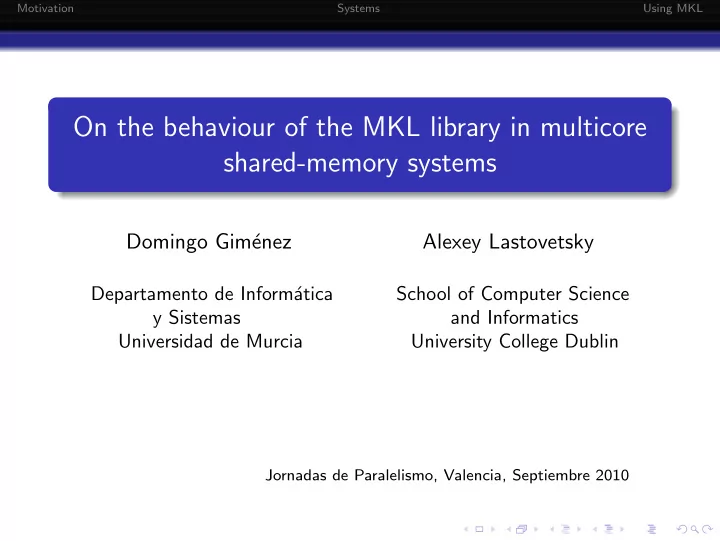

Motivation Systems Using MKL On the behaviour of the MKL library in multicore shared-memory systems Domingo Gim´ enez Alexey Lastovetsky Departamento de Inform´ atica School of Computer Science y Sistemas and Informatics Universidad de Murcia University College Dublin Jornadas de Paralelismo, Valencia, Septiembre 2010
Motivation Systems Using MKL Matrix multiplication on platforms composed of multicore The goal: To identify the shape matrix multiplication has in a multicore as a function of the problem size and the number of threads, to decide the number of threads to use to obtain the lowest execution time To use this information to develop two-level (OpenMP+BLAS) versions of the multiplication, and select the number of threads in each level To use this information to develop three-level (MPI+OpenMP+BLAS) versions, and select the number of processes and threads in each level To use this information to develop heterogeneous/distributed three-level (MPI+OpenMP+BLAS) versions, and select the number of processes and its distribution or the data partition, and in each processor the number of threads in each level
Motivation Systems Using MKL Matrix multiplication on platforms composed of multicore The goal: To identify the shape matrix multiplication has in a multicore as a function of the problem size and the number of threads, to decide the number of threads to use to obtain the lowest execution time To use this information to develop two-level (OpenMP+BLAS) versions of the multiplication, and select the number of threads in each level To use this information to develop three-level (MPI+OpenMP+BLAS) versions, and select the number of processes and threads in each level To use this information to develop heterogeneous/distributed three-level (MPI+OpenMP+BLAS) versions, and select the number of processes and its distribution or the data partition, and in each processor the number of threads in each level
Motivation Systems Using MKL Matrix multiplication on platforms composed of multicore The goal: To identify the shape matrix multiplication has in a multicore as a function of the problem size and the number of threads, to decide the number of threads to use to obtain the lowest execution time To use this information to develop two-level (OpenMP+BLAS) versions of the multiplication, and select the number of threads in each level To use this information to develop three-level (MPI+OpenMP+BLAS) versions, and select the number of processes and threads in each level To use this information to develop heterogeneous/distributed three-level (MPI+OpenMP+BLAS) versions, and select the number of processes and its distribution or the data partition, and in each processor the number of threads in each level
Motivation Systems Using MKL Matrix multiplication on platforms composed of multicore The goal: To identify the shape matrix multiplication has in a multicore as a function of the problem size and the number of threads, to decide the number of threads to use to obtain the lowest execution time To use this information to develop two-level (OpenMP+BLAS) versions of the multiplication, and select the number of threads in each level To use this information to develop three-level (MPI+OpenMP+BLAS) versions, and select the number of processes and threads in each level To use this information to develop heterogeneous/distributed three-level (MPI+OpenMP+BLAS) versions, and select the number of processes and its distribution or the data partition, and in each processor the number of threads in each level
Motivation Systems Using MKL Systems, basic components name architecture icc MKL rosebud05 4 Itanium dual-core 11.1 10.2 8 cores rosebud09 1 AMD quad-core 11.1 10.2 4 cores hipatia8 2 Xeon E5462 quad-core 10.1 10.0 8 cores hipatia16 4 Xeon X7350 quad-core 10.1 10.0 16 cores arabi 2 Xeon L5450 quad-core 11.1 10.2 8 cores ben HP Integrity Superdome 11.1 10.2 128 cores bertha IBM 16 Xeon X7460 hexa-core 11.0 11.0 96 cores
Motivation Systems Using MKL Systems Rosebud (Polytechnic Univ. of Valencia): cluster with 38 cores 2 nodes single-processors, 2 nodes dual-processors, 2 nodes with 4 dual-core, 2 nodes with 2 dual-core, 2 nodes with 1 quad-core Hipatia (Polytechnic Univ. of Cartagena): cluster with 152 cores 16 nodes with 2 quad-core, 2 nodes with 4 quad-core, 2 nodes with 2 dual-core Ben-Arabi (Supercomputing Centre of Murcia): Shared-memory + cluster: 944 cores Arabi: cluster of 102 nodes with 2 quad-core Ben: HP Superdome, cc-NUMA with 128 cores Bertha (INRIA Bordeaux Ouest): Shared-memory cc-NUMA: 96 cores 4 nodes, each node 4 processors, each processor hexa-core
Motivation Systems Using MKL Ben architecture Hierarchical composition with crossbar interconnection. Two basic components: the computers and two backplane crossbars. Each computer has 4 dual-core Itanium-2 and a controller to connect the CPUs with the local memory and the crossbar commuters. The maximum memory bandwidth in a computer is 17.1 GB/s and with the crossbar commuters 34.5 GB/s. The access to the memory is non uniform and the user does not control where threads are assigned.
Recommend
More recommend